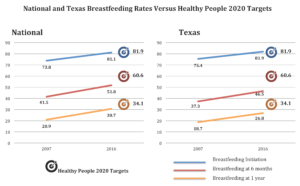Community Blog:- How communities can help nursing moms sustain breastfeeding
May 26, 2017 • Uncategorized
College of Public Health & Texas Center for Health Disparities
Community Blog
Engaging the Community Guest Blogger: Dani Cagle, MPH, CPH, IBCLC
Few mommy-moments are as intimate as breastfeeding. From the perspective of a health professional, there is no question that breast milk is the best nutrition for a newborn. As a new mom, I had many concerns.
Like so many new mothers, I wanted the health advantages of breastfeeding for myself and my daughter. Learning about these benefits led me to initiate breastfeeding. The public health community has done a great job promoting the benefits of breastfeeding and as a result, the amount of people starting breastfeeding increased nationwide from 73.8% in 2007 to 81.1% in 2016.
Although more moms choose to start breastfeeding, moms continuing to breastfeed does not match recommended timeframes. The American Academy of Pediatrics recommends exclusive breastfeeding for about 6 months, however, only 22.3% of American moms meet this goal. Since the benefits of breastfeeding have been widely shared, the next step in breastfeeding promotion is not “Do you know about the benefits of breastfeeding?” Instead, we should ask, “How can we help breastfeeding fit into your life?” The infrastructure of our communities, health care and social service delivery systems, schools, and workplaces must be the next target of our promotion efforts. If a new mother is successfully breastfeeding but is returning to school or work where pumping is not convenient or encouraged, then she most likely will not continue.
 Without a doubt, there is far more to celebrate about Motherhood than breastfeeding and we recognize that it is not always a viable option for all moms. However, it is vital for communities and organizations to support this powerful public health issue and personal health choice. Who could argue against improved mother-baby bonding? Or optimal nutrition and decreased newborn hospitalizations? Or a lower carbon footprint for infant feeding practices? Therefore, we all have a role to play in removing barriers to breastfeeding success.
Without a doubt, there is far more to celebrate about Motherhood than breastfeeding and we recognize that it is not always a viable option for all moms. However, it is vital for communities and organizations to support this powerful public health issue and personal health choice. Who could argue against improved mother-baby bonding? Or optimal nutrition and decreased newborn hospitalizations? Or a lower carbon footprint for infant feeding practices? Therefore, we all have a role to play in removing barriers to breastfeeding success.
As the Breastfeeding Coordinator for the City of Dallas Women, Infants, and Children (WIC) program, I am honored to address these issues every day! It is my responsibility to ensure that all WIC clients are properly informed and supported when they choose to breastfeed their babies. My role includes promoting breastfeeding to our pregnant clients; ensuring that we address any concerns or problems that the mother may encounter throughout her breastfeeding journey; and building community partnerships to provide a strong continuity of support between health care and social service providers.
As new moms, we all have questions. The public health community has educated and supported the choice to start breastfeeding. Now it is time to remove the obstacles to improve breastfeeding exclusivity and duration. The next time you see a nursing mother, give her a kind word of encouragement or a smile. Remember that she is choosing to make breastfeeding fit into her life – which benefits all of us. We all bear the burden of low breastfeeding rates – and we can all share in the successes of a healthy generation of breastfed children and greener communities.

Research reported in this publication was supported by the National Institute On Minority Health And Health Disparities of the National Institutes of Health under Award Number U54MD006882. The content is solely the responsibility of the authors and does not necessarily represent the official views of the National Institutes of Health.



Social media